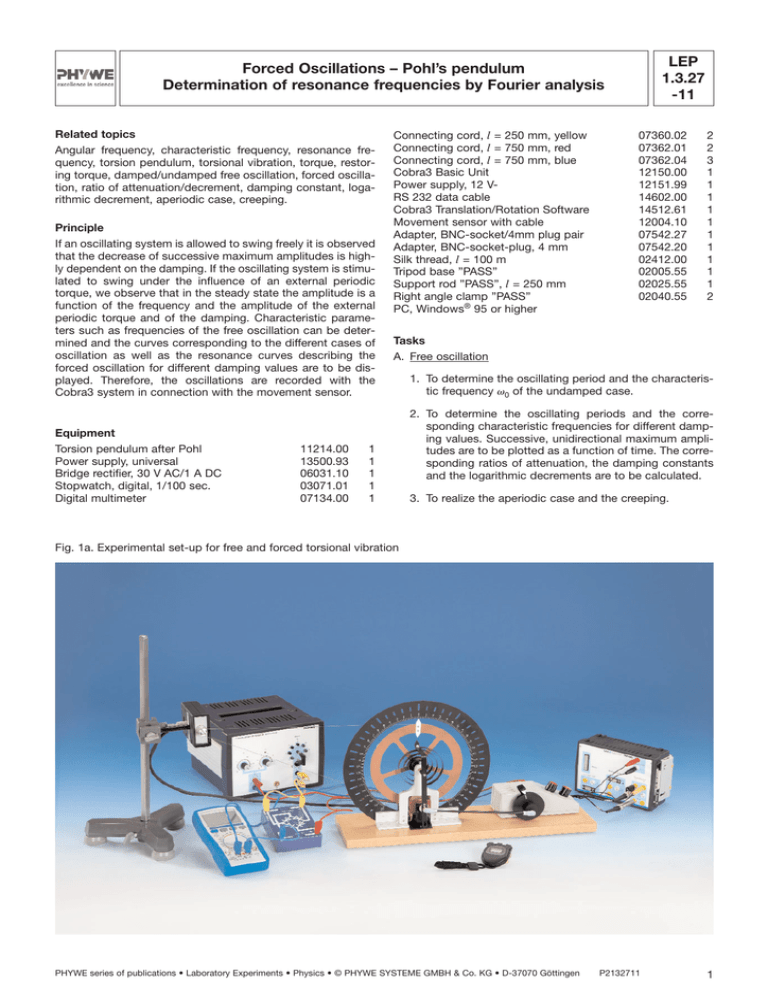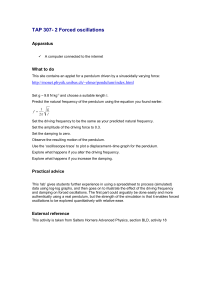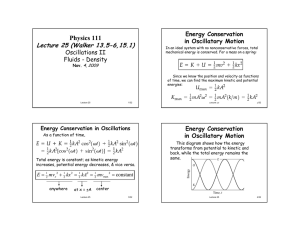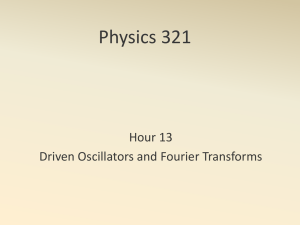LEP 1.3.27 -11 Forced Oscillations – Pohl`s pendulum
advertisement

LEP 1.3.27 -11 Forced Oscillations – Pohl’s pendulum Determination of resonance frequencies by Fourier analysis Related topics Angular frequency, characteristic frequency, resonance frequency, torsion pendulum, torsional vibration, torque, restoring torque, damped/undamped free oscillation, forced oscillation, ratio of attenuation/decrement, damping constant, logarithmic decrement, aperiodic case, creeping. Principle If an oscillating system is allowed to swing freely it is observed that the decrease of successive maximum amplitudes is highly dependent on the damping. If the oscillating system is stimulated to swing under the influence of an external periodic torque, we observe that in the steady state the amplitude is a function of the frequency and the amplitude of the external periodic torque and of the damping. Characteristic parameters such as frequencies of the free oscillation can be determined and the curves corresponding to the different cases of oscillation as well as the resonance curves describing the forced oscillation for different damping values are to be displayed. Therefore, the oscillations are recorded with the Cobra3 system in connection with the movement sensor. Equipment Torsion pendulum after Pohl Power supply, universal Bridge rectifier, 30 V AC/1 A DC Stopwatch, digital, 1/100 sec. Digital multimeter 11214.00 13500.93 06031.10 03071.01 07134.00 Connecting cord, l = 250 mm, yellow Connecting cord, l = 750 mm, red Connecting cord, l = 750 mm, blue Cobra3 Basic Unit Power supply, 12 VRS 232 data cable Cobra3 Translation/Rotation Software Movement sensor with cable Adapter, BNC-socket/4mm plug pair Adapter, BNC-socket-plug, 4 mm Silk thread, l = 100 m Tripod base ”PASS” Support rod ”PASS”, l = 250 mm Right angle clamp ”PASS” PC, Windows® 95 or higher 07360.02 07362.01 07362.04 12150.00 12151.99 14602.00 14512.61 12004.10 07542.27 07542.20 02412.00 02005.55 02025.55 02040.55 2 2 3 1 1 1 1 1 1 1 1 1 1 2 Tasks A. Free oscillation 1 1 1 1 1 1. To determine the oscillating period and the characteristic frequency v0 of the undamped case. 2. To determine the oscillating periods and the corresponding characteristic frequencies for different damping values. Successive, unidirectional maximum amplitudes are to be plotted as a function of time. The corresponding ratios of attenuation, the damping constants and the logarithmic decrements are to be calculated. 3. To realize the aperiodic case and the creeping. Fig. 1a. Experimental set-up for free and forced torsional vibration PHYWE series of publications • Laboratory Experiments • Physics • © PHYWE SYSTEME GMBH & Co. KG • D-37070 Göttingen P2132711 1 LEP 1.3.27 -11 Forced Oscillations – Pohl’s pendulum Determination of resonance frequencies by Fourier analysis B. Forced oscillation 1. The resonance curves are to be determined and represented graphically using the damping values of A. 2. The resonance frequencies are to be determined and compared with the resonance frequency values found beforehand. Use a paper-fastener or the weight holder and hang it at the end of the thread to tighten it. So, the thread runs parallel and always leaves the pendulum perpendicular. Fig. 2. Connection of the movement sensor to the Cobra3 Basic Unit 3. The phase shift between the amplitudes of the torsion pendulum and of the stimulating external torque is to be observed for a small damping value with the stimulating frequency far below the resonance frequency in one case, and far above it in the other. Fig. 1b: Electrical connection of the experiment. red black yellow BNC1 BNC2 Procedure Set-up The experiment is set up as shown in Fig. 1a and 1b. The DC output U_ of the power supply unit is connected to the sockets on the right side of the DC motor. The eddy current brake also needs DC voltage. For this reason a rectifier is inserted between the AC output U_ of the power supply unit and the entrance to the eddy current brake. The value of the DC current supplied to the eddy current brake, IB, is indicated by the ammeter. Perform the electrical connection of the movement sensor to the Cobra3 Basic Unit according to Fig. 2. To obtain a connection between the movement sensor and the pendulum do as follows: Place the movement sensor at the end of the table to ensure that the used thread can easily swing. Take about 100 cm of thread (dependent on the distance between pendulum and sensor), tie a knot on it to form a loop and place it carefully in the groove of the copper-pendulum starting from the bottom. rotate the pendulum half and fix one end with some adhesive tape. Wind the other side of the closed thread around the larger of the two cord grooves on the movement sensor once, in a way similar to a bicycle chain. To reduce friction, let the trread run parallel to the plane of the copper-disk of the pendulum and adjust the length of the thread. Too much of a tension increases friction, though there must be some friction at the grooves of the pendulum and of the movement sensor in order to be able to record the oscillation. Note: Make sure to place the knot between the pendulum and the movement sensor in a way that it will not cause extra friction at the grooves. 2 P2132711 FREE OSCILLATION – UNDAMPED CASE To determine the characteristic circular frequency v0 = 2π/T0 of the torsion pendulum without damping (IB = 0), the time for several oscillations—is measured repeatedly and the mean value of the period T0 calculated. Set the measuring parameters in measure according to Fig. 3. Select 12 mm for the ”axle diameter” of the movement sensor. The axis diameter in the ”Rotation” menu item is twice the distance from the pivot point of the pendulum to the groove around which the silk thread is wound, i.e. here about 185 mm. Fig. 3. Measuring parameters PHYWE series of publications • Laboratory Experiments • Physics • © PHYWE SYSTEME GMBH & Co. KG • D-37070 Göttingen Forced Oscillations – Pohl’s pendulum Determination of resonance frequencies by Fourier analysis Press the button ”continue” to enter the measurement window. Here, the actual value of the movement sensor is displayed. Set the pendulum in motion (oscillation amplitude up to 15 scale divisions) and click on ”Start measurement”. After approximately 5-10 oscillations click on the ”Stop measurement” icon. Fig.4 shows the recorded curve of this undamped oscillation. LEP 1.3.27 -11 If the values (50 ms) in the ”Get value every (50) ms” (Fig. 3) dialog box are too high or too low, noisy or non-uniform measurements can occur. In this case adjust the measurement sampling rate appropriately. There are different opportunities to determine the oscillation period and the characteristic frequency of the undamped case. The duration of the period can either be calculated with the aid of the cursor lines, which can be freely moved and shifted onto the adjacent maxima or minima of the oscillation curve (Fig. 5). Alternatively, use the item ”curve analysis” in the analysis menu, where the extrema of the chosen curve can be calculated. Or use ”Fourier analysis”, where the peak displays directly the period of the oscillation. FREE OSCILLATION – DAMPED CASE Characteristic frequencies for the damped oscillations are found in the same way as for the undamped case. Rebuild the experimental set-up as described above, now using the following current intensities for the eddy current brake (controlled by the ammeter): Table for the current values for the eddy current brake: Remarks Initially, it has to be ensured that the pendulum pointer at rest coincides with the zero-position of the scale. This can be achieved by turning the eccentric disc of the motor. IB IB IB IB IB ~ ~ ~ ~ ~ 0.16 0.34 0.52 0.70 0.88 A, A, A, A, A, (U~ (U~ (U~ (U~ (U~ = = = = = 2 V) 4 V) 6 V) 8 V) 12 V) Fig. 6 shows the curve of the damped case with IB ~ 0.25 A. Try to rotate the pendulum carefully and release it quickly without friction of your hand. This avoids disturbances of the thread and damping of the pendulum, which can lead to measurement errors. To realize the aperiodic case (delta ~ v0, IB ~ 1.5 A) and the creeping Case (delta > v0, IB ~ 1.7 A) the eddy current brake is briefly connected directly to the DC output U_ of the power supply unit. Fig. 5: Calculation of the period duration with cursor lines Fig. 6: Recorded curve of the damped oscillation PHYWE series of publications • Laboratory Experiments • Physics • © PHYWE SYSTEME GMBH & Co. KG • D-37070 Göttingen P2132711 3 LEP 1.3.27 -11 Forced Oscillations – Pohl’s pendulum Determination of resonance frequencies by Fourier analysis The calculation of the oscillating periods is the same as described above. To evaluate the characteristic damping values, determine the magnitude of successive amplitudes on the same side (i.e. either minima or maxima). In order to do that, use the cursor lines again or chose the curve-analysis function in the analysis menu. Here, you can calculate the extrema of the curve and use them directly for the determination of the damping ratio (Fig. 7). Alternatively, use ”line fitting”, where the coefficients of a damped cosinus curve (ae-dt · cos (bx+c) which fits best the obvservation, correspond to the values of the amplitude a, frequency b, phase c and attenuation d. Forced oscillation To stimulate the torsion pendulum, the rim in the motor is fixed to the upper third of the rod in the lever arm at the back side of the pundulum in order to obtain sufficiently large amplitudes. The DC voltage U_ of the power supply unit must be set to maximum. The stimulating frequency va of the motor can be found by using a stopwatch and counting the number of turns. The amplitudes of the forced oscillation are recorded in the same way as for the free oscillations. The measurement begins with small frequencies. va is increased by means of the motor-potentiometer setting ”coarse”. In the vicinity of the maximum amplitude in the resonance case va is changed in small steps using the potentiometer setting ”fine”. In each case, values should be taken into account only after a stable pendulum amplitude has been established. The higher the damping values are the faster this steady state is reached. Remarks — In extremely short oscillation periods, signal transients or deformations can occur. These can be reduced if the sampling rate is changed. In any case, error-free recorded intervals can be selected from the measuring signal after completion of the measurements. — Sickle-shaped deformation of the oscillations are due to slippage of the thread across the cord groove on the movement sensor. This is avoided if the thread is wound around the cord groove once. — Since the movement recording is not performed without contact, slight damping of the measured oscillations does occur, but the difference between ”nearly undamped” and damped oscillations is very significant. Theory and evaluation A. Undamped and damped free oscillation In case of free and damped torsional vibration torques M1 (spiral spring) and M2 (eddy current brake) act on the pendulum. We have M1 = – D0 f and M2 = – Cf f · f D0 C = = = = angle of rotation angular velocity torque per unit angle factor of proportionality depending on the current which supplies the eddy current brake The resultant torque M = – D0f – Cf Fig. 8 shows the measured curve near the resonance frequency for a small damping value (IB ~ 0.16 A). leads us to the following equation of motion: .. If + Cf + D0f = 0 In the absence of damping or for only very small damping values, va must be chosen in such a way that the pendulum does not exceed its scale range (resonance catastrophe). Therefore, in the resonance regime the measurement has to be stopped before the maximum values are reached. Again, the maximum oscillation amplitudes can be calculated with the aid of the cursor lines or with the curve analysis. The resonance frequencies can be determined by Fourier analysis. (1) I.. = pendulum’s moment of inertia f = angular acceleration Fig. 8: Forced oscillations for a small damping value Fig. 7: Curve analysis parameters 4 P2132711 PHYWE series of publications • Laboratory Experiments • Physics • © PHYWE SYSTEME GMBH & Co. KG • D-37070 Göttingen Forced Oscillations – Pohl’s pendulum Determination of resonance frequencies by Fourier analysis where Dividing Eq. (1) by I and using the abbreviations d= C D0 and v20 = 2I I fa results in .. f + 2 df + v20f = 0 f0 va 2 2 d va 2 d e1 c d f c2 v v A 0 0 v0 (9) (2) and f0 = d is called the “damping constant” and v0 = LEP 1.3.27 -11 D0 B I F0 v20 Furthermore: the characteristic frequency of the undamped system. tan a = 2 dva v20 – v2a The solution of the differential equation (2) is respectively f(t) = f0e-dt cos vt (3) a = arc tan with v = 2v20 d2 (4) Eq. (3) shows that the amplitude f(t) of the damped oscillation has decreased to the e-th part of the initial amplitude f0 after the time t = 1/d has elapsed. Moreover, from Eq. (3) it follows that the ratio of two successive amplitudes is constant. fn = K = edT fn1 (5) 2 dva (10) v20 – v2a An analysis of Eq. (9) gives evidence of the following: 1. The greater F0 , the greater fa 2. For a fixed value F0 we have: f S fmax for va v0 3. The greater d, the smaller fa 4. For d = 0 we find: fa S ∞ if va = v0 K is called the “damping ratio” and the quantity = ln K = dT = ln fn fn1 (6) is called the “logarithmic decrement”. Eq. (4) has a real solution only if v20 d2. For v20 = d2, the pendulum returns in a minimum of time to its initial position without oscillating (aperiodic case). For v20 < d2, the pendulum returns asymptotically to its initial position (creeping). Fig. 9: Phase shift between the amplitudes of the pendulum and of the motor in the case of the forced oscillation for different damping values B. Forced oscillation If the pendulum is acted on by a periodic torque Ma = M0 cos vat Eq. (2) changes into .. f + 2 df + v20f = F0 cos vat where F0 = (7) M0 I In the steady state, the solution of this differential equation is f(t) fa cos (vat – a) (8) PHYWE series of publications • Laboratory Experiments • Physics • © PHYWE SYSTEME GMBH & Co. KG • D-37070 Göttingen P2132711 5 LEP 1.3.27 -11 Forced Oscillations – Pohl’s pendulum Determination of resonance frequencies by Fourier analysis Results Typical values for this experimental set-up are: For very small frequencies va the phase difference is approximately zero, i.e. the pendulum and the stimulating torque are ”in phase”. If va is much greater than v0, pendulum and stimulating torque are nearly in opposite phase to each other. — T0 = (1.75 ± 0.05) sec; — = (3.59 ± 0.10) sec–1 v 0 I 1/d d v K 0.16 11.1 0.09 3.58 1.17 0.16 0.34 3.8 0.26 3.57 1.58 0.46 0.52 2.0 0.51 3.54 2.47 0.91 0.70 1.2 0.85 3.50 4.60 1.53 0.88 0.8 1.30 3.42 10.89 2.39 Fig. 9 shows the phase difference of the forced oscillation as a function of the stimulating frequency according to Eq. (10). Fig. 10 illustrates the decrease in the unidirectional amplitude values as a function of time for free oscillation and different damping values. Fig. 11 shows the resonance curves for different damping values. Evaluating the curves leads to medium resonance frequency v = 3.59 s–1. Furthermore, the software allows to calculate the Fourierspectra of the recorded oscillations. With this opportunity it can easily be shown that for increasing damping values the frequency of maximum amplitude shifts to smaller values (see Fig.12). Fig.10: Maximum values of unidirectional amplitudes as a function of time for different damping values. 6 P2132711 PHYWE series of publications • Laboratory Experiments • Physics • © PHYWE SYSTEME GMBH & Co. KG • D-37070 Göttingen Forced Oscillations – Pohl’s pendulum Determination of resonance frequencies by Fourier analysis LEP 1.3.27 -11 Fig. 11: Resonance curves for different damping values. Fig. 12: Fourier-spectra for different damping values, increasing left to right. PHYWE series of publications • Laboratory Experiments • Physics • © PHYWE SYSTEME GMBH & Co. KG • D-37070 Göttingen P2132711 7 LEP 1.3.27 -11 8 Forced Oscillations – Pohl’s pendulum Determination of resonance frequencies by Fourier analysis P2132711 PHYWE series of publications • Laboratory Experiments • Physics • © PHYWE SYSTEME GMBH & Co. KG • D-37070 Göttingen






